The last of the Camellias
Winter is over and so too are Camellias. They bloom from December into early April. Here are the last blooms from my plants which I overwinter in a cold room in my house.
Winter is over and so too are Camellias. They bloom from December into early April. Here are the last blooms from my plants which I overwinter in a cold room in my house.
When it snows for the first time I’m out in the garden looking for tracks of deer which have been invisible up to now. I’m tracking where they go so I can put up barriers so they don’t get near my beautiful Hemlocks and Japanese Yew which they will chew up and devastate.
Deer are all around these parts, but not a problem until winter when they start foraging.
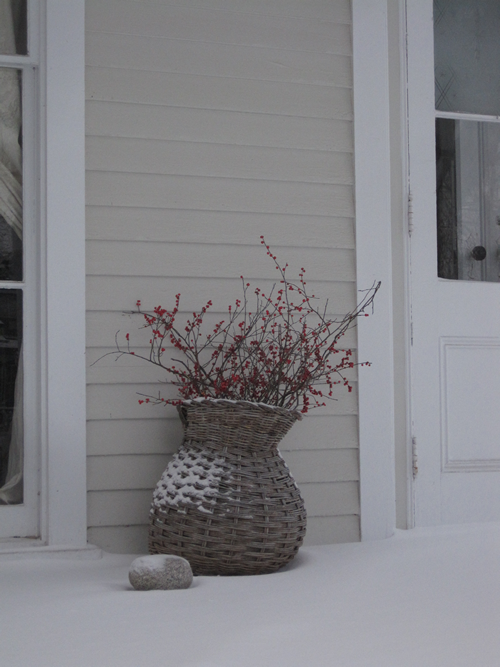
Winterberry – Ilex of some sort that grow wild near the roadside
in an old basket for picking apples.
I live in an amazing part of the country with snow, moon, cherry blossoms in spring and autumn colors like these just showing off a month ago. How quickly things change…
Indian summer has come to an end. The nights are cold and even though we haven’t had a hard frost yet, I’ve brought in the Camellias to over winter. I also dug up the Papyrus ‘King Tut’ that I have been growing this year in the garden. In the pots they seem huge. I’ll keep them well watered and hope they make it through the winter.
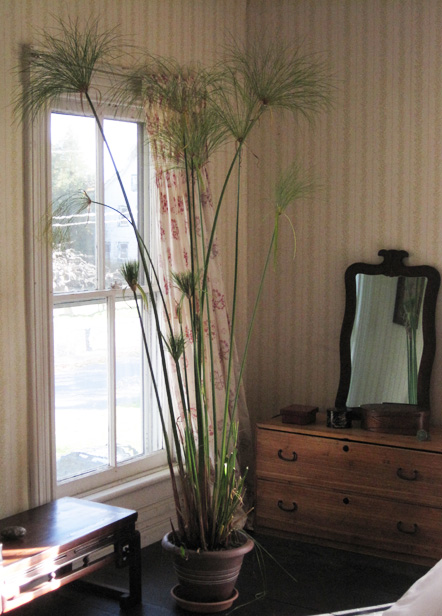
In the garden this Papyrus didn’t seem so big, but it’s almost touching the ceiling of my bedroom where I hope it survives the winter.
Click here to read more about my Camellias and how we use them for Tea
Jiny Blom, a well known landscape designer said “Take risks. If someone tells you something is impossible, see if you can do it. Gardening is a knife edge between disaster and serendipity.”
I felt she was talking directly to me when I built this stone path.
I collected the rocks from an old stone wall on my mother’s property. I dug a trench 8 inches deep and filled it with 800 pounds of rock dust and sand, then pieced the stones together like a quilt or jigsaw puzzle.
Rikyu, the brilliant tea master of the 16th century, said that the design of the Roji should be sixty percent practical and forty percent aesthetic. This path meets his criteria.
I’ve planted creeping thyme in the spaces between the stones. I wasn’t sure it would like the conditions: was there enough light, was the soil too sandy, did it drain well enough…? It’s taken a couple of years but slowly the thyme is making itself at home.
The path needs periodic weeding. I get down on my hands and knees, my nose inches from the stones and delicatly separate the weeds from the thyme. It’s a garden job that could easily be forgotten or put aside as too much trouble, but in the late afternoon when the light is gentle and the air soft, to get down on the ground inches from the earth is a task I’m grateful for.
– excerpt from A Tea Garden in Tivoli
Hedges and fences form the bones of a garden and create rooms with distinct styles. What starts out as a blank slate now has a frame that can be filled. One of the first things I did in my garden was to plant thirty feet of privet along my property line to enclose the flower garden and give me a sense of a “secret garden”, a walled place set apart from my neighbors.
The most magnificent privet I”ve ever seen are grown in the Hampton”s of New York and used everywhere. Here”s a typical, perfectly manicured hedge that screens a house.
“How do they get that tall and so beautifully sculpted?”
That”s been my question ever since I planted my little, two foot high shrubs ten years ago. Well, it turns out that here in the Hudson Valley it”s not so easy. There”s not enough sun, or there”s not enough “something” to make the Privet take off like they do in Long Island.
Pruning is difficult. Most people will get their electric pruners out and just top the growth, which creates more density, but in our case that would mean keeping the privet to about three feet tall; we wanted them much higher! Over the years I”ve hand pruned the hedge making sure that the top is thinner than the bottom like the diagram on the right. It needs to have the shape of a modified pyramid.
 I”ve also hand clipped long straggly stems in the middle of the hedge that don”t have growth on the center and only leaf out on top where there”s enough light. It”s tricky. The more you prune, the bushier the growth as you can see from the diagram on the far left , but you loose that undergrowth that makes such a perfect hedge.
I”ve also hand clipped long straggly stems in the middle of the hedge that don”t have growth on the center and only leaf out on top where there”s enough light. It”s tricky. The more you prune, the bushier the growth as you can see from the diagram on the far left , but you loose that undergrowth that makes such a perfect hedge.
But finally after ten years, my Privet has taken off and responded to my selective pruning. Now my problem is how to get to the top branches. I get on a ladder and have a long hand clipper, but it”s an arduous task and I can”t reach the top. I”m not complaining though! I”m thrilled they”re so high.
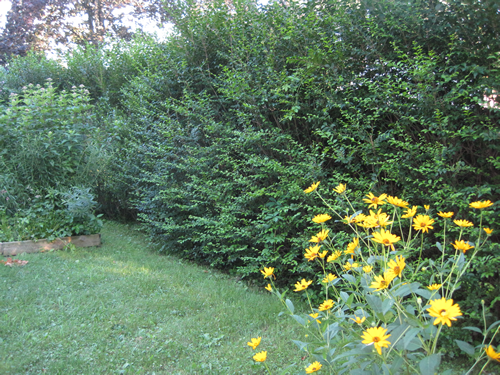
My Privet hedge has gotten so tall I can”t prune the tops. But this
is a wonderful year for this hedge. It”s finally come into it”s own!
So now I have to figure out how to get to the top. I asked my neighbor who has a lawn business to help out, but we”re not in the Hamptons. She has two guys on a ladder, who “might” be able to reach. Take a look at what the pros do…Yikes!
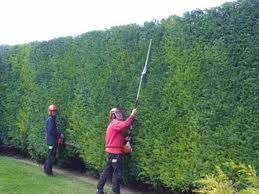 |
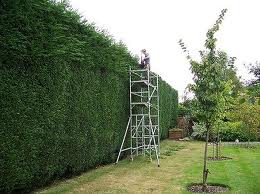 |
Late summer is here. Goldenrod has appeared which is always the first sign of autumn. Purple loosestrife and Queen Anne’s Lace are everywhere in fields. Besides the flowers growing in my own garden, I’ve been out picking from the roadside.
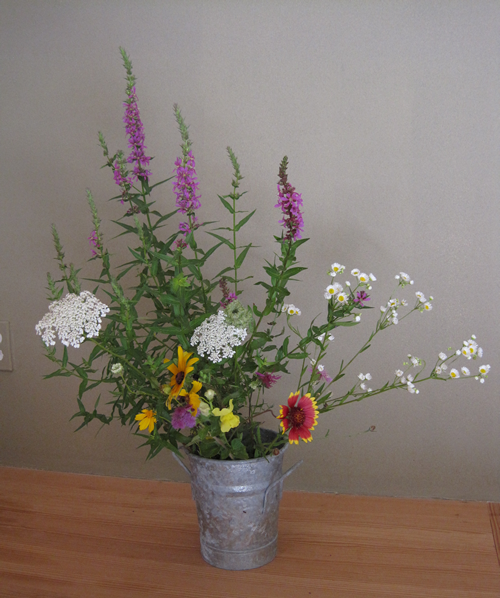
A bucket of wild flowers: purple Loosestrife, Queen Anne’s Lace, Black-eyed Susan, Daisy Fleabane, a Galardia that had self sown in the fields.
Here’s what I picked from my garden. All good flowers for Chabana as you will see.
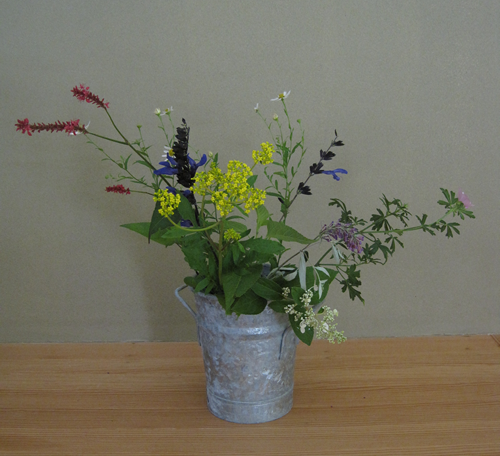
Flowers that are blooming now in my garden: Red Persicaria ‘Firetail’ or Mountain Fleeceflower, Salvia guaranitica ‘Black and Blue’, Oakleaf Hydrangea, a pink Mallow, and the yellow flower is a Wild Parsnip that self seeded.
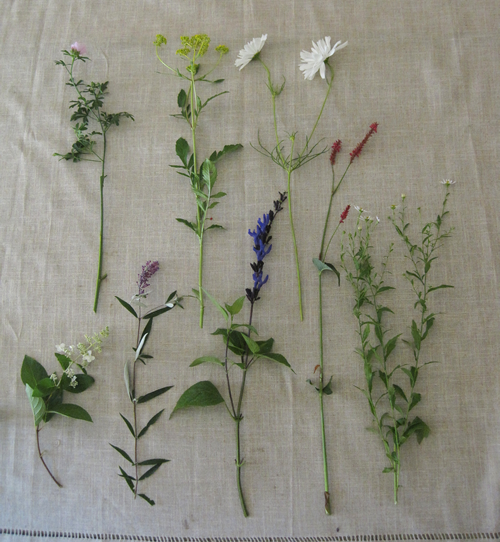
From top left clockwise: Mallow, Wild Parsnip, white Cosmos, Fleabane, Persicaria, Salvia, Buddlea, Hydrangea
One of the great joys of tea is flower arranging, or rather “placement of the flowers” for Chabana. Here you can see how we used the flowers blooming now.
